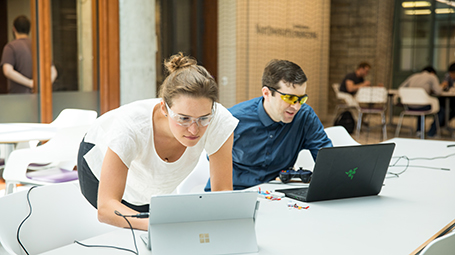Robotics Certficate
Robotics and embodied AI are where AI meets the physical world. Think humanoid robots, drones, self-driving cars, and more. Undergraduates can earn a Robotics Certificate to prepare for this dynamic field.
Bridging the gap between knowledge and experience with intensive training programs
Earn a PhD with a focus in robotics

To conduct graduate-level study with a Center for Robotics and Biosystems faculty member, prospective students apply directly through that faculty member’s department.
Prepare for an exciting career in the robotics industry
The Master of Science in Robotics program is a 12-15-month, full-time graduate program that equips students with the tools required of a robotics engineer. Designed to provide intense, hands-on training to bridge the knowledge and experience gap between an undergraduate engineering degree and a career in robotics, the program includes a broad array of concentrations including computer science, mechanical engineering, electrical engineering, biomedical engineering, and mathematics.
Learn About MSRStudy, research, create, and compete
Robotics and embodied AI are where AI meets the physical world. Think humanoid robots, drones, self-driving cars, and more. Undergraduates can earn a Robotics Certificate to prepare for this dynamic field.
The NU Robotics Club brings together a core community of undergraduate student builders interested in robotics. Projects range from technical research projects to start-up ideas to yearly competitions.
Every year teams of engineering undergraduates design, build, and program robots to compete for prizes in a spring competition. Prior to enrollment students must pass a milestone during winter quarter to be eligible to register.
Each year, students and faculty introduce their work to the public as part of this collection of events and activities at one of Chicago’s great museums.
The faculty at the Center for Robotics and Biosystems offer online courses through Coursera, including a six-course specialization on Modern Robotics by Professor Kevin Lynch.
Learn More and Register for Our Coursera CoursesPrinciples of Robot Motion, H. Choset, K. Lynch, et al.
Embedded Computing and Mechatronics with the PIC32 Microcontroller, K. Lynch et al. Read description
Modern Robotics, K. Lynch and F. Park. Read description
Trep is a Python module for modeling articulated rigid body mechanical systems in generalized coordinates. Trep supports basic simulation but it is primarily designed to serve as a calculation engine for analysis and optimal control algorithms that require 1st and 2nd derivatives of the system’s dynamics.
The Digital Rat is software from the Hartmann group that aims to enable morphologically and mechanically accurate modeling of the rat head and vibrissal (whisker) array. Our long-term goal is to develop a simulation environment that can be used to model the spatiotemporal patterns of mechanical input to vibrissae during the rat's tactile exploratory behaviors.
The Modern Robotics code library accompanies the book "Modern Robotics: Mechanics, Planning, and Control," by K. M. Lynch and F. C. Park. It implements many of the most common functions in robot kinematics, dynamics, and control. It is written in Python, MATLAB, and Mathematica to be easy to read and to reinforce the concepts in the book.
Learn with the Best
The Center for Robotics and Biosystems is proud that five of our core faculty are winners of the top teaching award at Northwestern. Mitra Hartmann, Kevin Lynch, Todd Murphey, and Michael Peshkin were awarded the Charles Deering McCormick Professorship of Teaching Excellence and Ed Colgate was recognized as the Alumnae of Northwestern Teaching Professor.